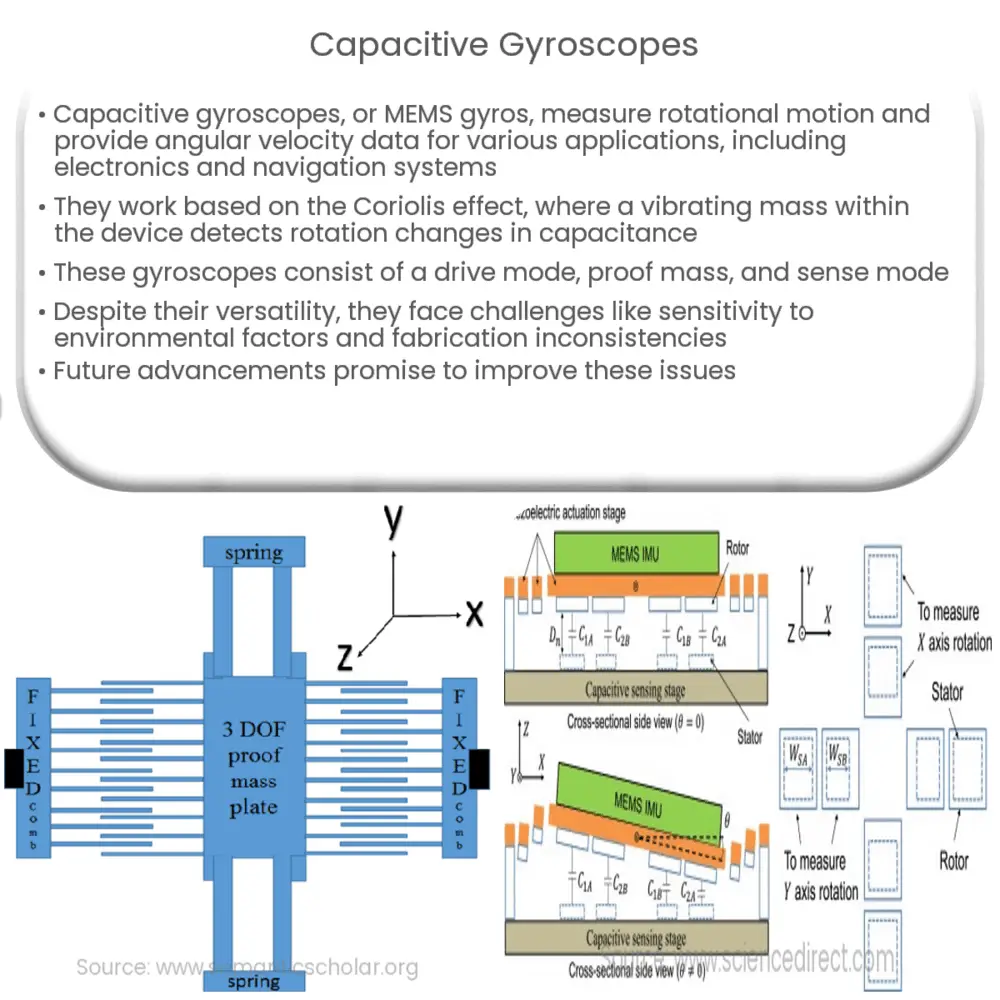Explore the world of capacitive gyroscopes, their operating principles, applications, challenges, and future prospects in our comprehensive guide.

Understanding Capacitive Gyroscopes
A capacitive gyroscope, commonly referred to as a MEMS (Micro-Electro-Mechanical Systems) gyro, is a small, solid-state device that can measure rotational motion. Its fundamental function is to provide information about angular velocity, which is key to a plethora of applications ranging from inertial navigation systems to consumer electronics.
Operational Principle
Capacitive gyroscopes operate on the principle of the Coriolis effect. When an object is moving in a rotating system, an inertial force, known as the Coriolis force, is exerted perpendicular to the direction of motion. In a capacitive gyroscope, a vibrating mass creates a Coriolis effect when the device rotates, and this rotation can be measured as a change in capacitance.
Components of a Capacitive Gyroscope
- Drive Mode: This component initiates a resonant vibration to the proof mass. The drive mode generally maintains motion at a specific frequency.
- Proof Mass: This is a moveable element within the device, typically kept in constant oscillation. When a rotation is sensed, due to the Coriolis effect, the mass is displaced.
- Sense Mode: The sense mode detects the motion of the proof mass. In capacitive gyroscopes, this motion is detected as a change in capacitance.
Functionality of Capacitive Gyroscopes
With the major components in place, the functionality of a capacitive gyroscope can be described in three steps. Initially, the drive mode sets the proof mass into a controlled vibration. As the device experiences rotation, the Coriolis effect displaces the proof mass, resulting in a movement that is perpendicular to the original vibration. This movement (or change in position) is then detected by the sense mode, which senses it as a change in capacitance. Consequently, the output is proportional to the rate of rotation.
Applications of Capacitive Gyroscopes
Capacitive gyroscopes have found widespread use in several fields due to their small size, high sensitivity, and low power requirements. These include:
- Consumer Electronics: Used in smartphones, tablets, and gaming controllers to detect rotation and motion.
- Automotive: Implemented in vehicle stability control and navigation systems.
- Aviation: Essential for inertial navigation systems in aircraft.
Despite their advantages, capacitive gyroscopes are not without challenges. The next section will delve into these, as well as the future prospects for this technology.
Challenges and Future Prospects
While capacitive gyroscopes provide significant benefits, they are not without their challenges. One of the primary issues relates to sensitivity and stability. As these devices work on the principle of detecting changes in capacitance, external environmental factors like temperature fluctuations and mechanical vibrations can impact accuracy.
Another challenge lies in the fabrication process. Constructing MEMS devices requires complex microfabrication techniques that can sometimes lead to inconsistencies in the produced parts. Furthermore, as these devices get smaller, the impact of these inconsistencies becomes more significant.
However, the future of capacitive gyroscopes looks promising. Advancements in microfabrication technologies are expected to mitigate some of these challenges. More precise and reliable manufacturing processes will likely lead to enhanced performance in these devices. Additionally, research is being conducted to improve temperature compensation techniques, aiming to minimize environmental impacts on the device’s operation.
Conclusion
Capacitive gyroscopes are an integral part of many modern technologies, playing a crucial role in maintaining orientation and direction in a vast array of applications. Despite facing several challenges, such as sensitivity to environmental changes and manufacturing complexities, these devices are poised for ongoing development and refinement. As technology advances, we can expect to see even more precise and reliable capacitive gyroscopes being produced, further expanding their application range and cementing their status as an indispensable element in the field of motion sensing and navigation.

